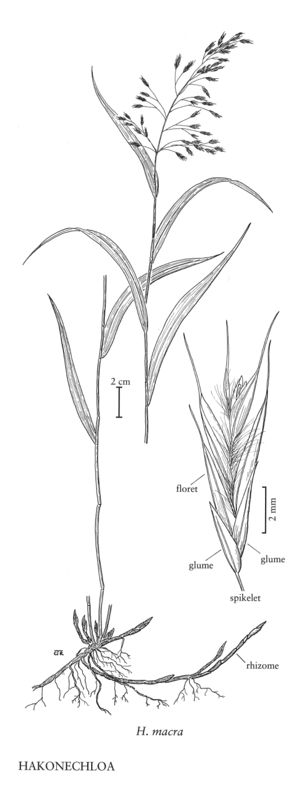Hakonechloa macra
Rhizomes and stolons covered with pale, coriaceous scales. Culms 30-90 cm tall, 1-1.5 mm thick, glabrous. Adaxial ligules 0.2-0.3 mm; blades 8-25 cm long, 0.4-1.2 cm wide, glabrous, abaxial surfaces green, adaxial surfaces often paler, turning orange-bronze in the fall. Panicles 6-12 cm long, 5-7 cm wide, open, nodding, with 15-30 spikelets; branches paired, somewhat stiff, scabrous. Spikelets 1-2 cm, yellowish-green, with 5-10 florets. Glumes broadly lanceolate; lower glumes 3-4 mm, 1-3-veined; upper glumes 3.8-5 mm, 3-veined; calluses 1.5-2 mm, strigose, hairs 1-1.5 mm; lemmas 6-7 mm long, 1.8-2.2 mm wide, chartaceous, 3-veined, margins sparsely pilose with long papillose-based hairs near the base, awned; awns 3-5 mm; anthers 2-3 mm. Caryopses about 2 mm. 2n = 50.
Distribution
Utah
Discussion
In Japan, Hakonechloa macra grows on rocks along rivers. Although rhizomatous, it is not an invasive species and is recommended for mass planting. Three forms are cultivated: forma alboaurea Makino ex Ohwi, with white- and yellow-striped leaves; forma albovariegata Makino ex Ohwi, with white-striped leaves; and forma aureola Makino ex Ohwi, with yellow leaves having narrow green stripes. This last form is the one most commonly available in the Flora region.
Selected References
None.
Lower Taxa
"decumbent" is not a number.
